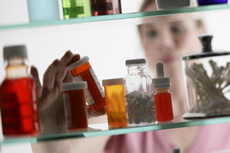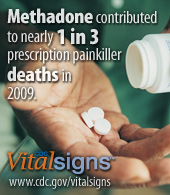Poisoning in the United States: Fact Sheet
Overview
Every day in the United States, 87 people die as a result of unintentional poisoning, and another 2,277 are treated in emergency departments (ED).1
A poison is any substance, including medications, that is harmful to your body if too much is eaten, inhaled, injected, or absorbed through the skin. Any substance can be poisonous if too much is taken.
Poisonings are either intentional or unintentional. This fact sheet provides information on the problem of unintentional poisoning in the United States. If the person taking or giving a substance did not mean to cause harm, then it is an unintentional poisoning.
Unintentional poisoning includes the use of drugs or chemicals for nonmedical purposes in excessive amounts, such as an “overdose.” It also includes the excessive use of drugs or chemicals for non-recreational purposes, such as by a toddler.
The Problem
- In 2009, 31,758 (76 percent) of the 41,592 poisoning deaths in the United States were unintentional, and 3,349 (8 percent) were of undetermined intent.1 Unintentional poisoning death rates have been rising steadily since 1992.1
- Unintentional poisoning was second only to motor vehicle crashes as a cause of unintentional injury death for all ages in 2009. Among people 25 to 64 years old, unintentional poisoning caused more deaths than motor vehicle crashes.1
- In 2010, unintentional poisoning caused about 831,295 emergency department (ED) visits.1
- 206,479 (25 percent) of these ED visits resulted in hospitalization or transfer to another facility.1
- In 2010, poison control centers reported receiving calls about 2.4 million human poison exposure cases.2
- Between 2004 and 2005, an estimated 71,000 children (<18 years of age) were seen in EDs each year because of medication poisonings (excluding abuse and recreational drug use). Over 80 percent were because an unsupervised child found and consumed medications.3
Most Common Poisons

- In 2009, 28,754 (91 percent) of all unintentional poisoning deaths were caused by drugs. The class of drugs known as prescription painkillers, which includes such drugs as methadone, hydrocodone, and oxycodone, was most commonly involved, followed by cocaine and heroin.4
- Among those treated in EDs for nonfatal poisonings involving nonmedical use of prescription or over-the-counter drugs in 2009, opioid pain medications and benzodiazepines (such as Valium) were involved most frequently.5Nonmedical use includes misuse, abuse or otherwise not taking a drug as prescribed.
- Among children, ED visits for medication poisonings (excluding misuse or abuse) are twice as common as poisonings from other household products (such as cleaning solutions and personal care products).3
Costs
- In 2005, poisonings led to $33.4 billion in medical and productivity costs.6
Groups at Risk for Poisoning
Among those who died from unintentional poisoning in 2009:
- Men were nearly twice as likely as women to die;
- American Indians/Alaska Natives had the highest death rate, followed by Whites and then Blacks
- The highest mortality rates were among people 45-49 years of age; and
- The lowest mortality rates were among children less than 15 years old because they do not abuse drugs as frequently as older people.1
Among people who unintentionally poisoned themselves and received treatment in emergency departments in 2010:
- Men were 1.6 times more likely than women to make such ED visits;
- The highest rates were in the 45-49 year old age group.1
Among children, ED visits for medication poisonings are most common in children <6 years of age.
- One out of every 180 two-year-olds visits an emergency department for a medication poisoning.3
Policy Impact: Prescription Painkiller Overdoses
 Policy Impact: Prescription Painkiller Overdoses is one in a series of issue briefs highlighting key public health issues and important, science-based policy actions that can be taken to address them. Through this publication, CDC supports state-based efforts to reduce prescription drug abuse while ensuring patients have access to safe, effective pain treatment.
Policy Impact: Prescription Painkiller Overdoses is one in a series of issue briefs highlighting key public health issues and important, science-based policy actions that can be taken to address them. Through this publication, CDC supports state-based efforts to reduce prescription drug abuse while ensuring patients have access to safe, effective pain treatment.
Additional Information Sources
- Vital Signs: Prescription Painkiller Overdoses in the US
- Policy Impact: Prescription Painkiller Overdoses
- CDC Public Health Grand Rounds: "Prescription Drug Overdoses: An American Epidemic"
- CDC's Medication Safety Program
- CDC's PROTECT Initiative
- CDC's Protect the Ones You Love: Poisonings
- CDC's National Center for Environmental Health: Carbon Monoxide Poisoning and Lead Poisoning
- Substance Abuse and Mental Health Services Administration
- American Association of Poison Control Centers, Inc.
- Up and Away and Out of Sight Campaign for safe medicine storage
- Physicians for Responsible Opioid Prescribing: Cautious, Evidence-based Opioid Prescribing
Related Publications
- Paulozzi LJ, Weisler RH, Patkar AA. A National Epidemic of Unintentional Prescription Opioid Overdose Deaths: How Physicians Can Help Control It. J Clin Psychiatry. 2011; 72(5):589-592.
- Centers for Disease Control and Prevention. Drug Overdose Deaths --- Florida, 2003--2009. MMWR 2011;60(26);869-872.
- Centers for Disease Control and Prevention. Unintentional and undetermined poisoning deaths—11 states, 1990-2001. MMWR 2004;53:233-8.
- Centers for Disease Control and Prevention. Nonfatal, unintentional medication exposures among young children—United States, 2001-2003. MMWR 2006;55:1-5.
- Paulozzi LJ, Budnitz DS, Xi Y. Increasing deaths from opioid analgesics in the United States. Pharmacoepidemiology and Drug Safety 2006; 15:618-627.
- Paulozzi LJ, Annest J. US data show sharply rising drug-induced death rates. Injury Prevention 2007;13:130-132.
- Centers for Disease Control and Prevention. Unintentional poisoning deaths—United States, 1999-2004. MMWR 2007;56:93-96.
- Hall AJ, Logan JE, Toblin RL, Kaplan JA, Kraner JC, Bixler D, Crosby AE, Paulozzi LJ. Patterns of abuse among unintentional pharmaceutical overdose fatalities. JAMA 2008;300:2613-2620.
- Paulozzi LJ, Logan JE, Hall AJ, McKinstry E, Kaplan JA. A comparison of drug overdose deaths involving methadone and other opioid analgesics in West Virginia. Addiction 2009; 104:1541-1548.
- Centers for Disease Control and Prevention. Overdose deaths involving prescription opioids among Medicaid enrollees—Washington, 2004-2007. MMWR 2009;58:1171-1175.
- Warner M, Chen LH, Makuc DM. Increase in fatal poisonings involving opioid analgesics in the United States, 1999–2006. NCHS data brief, no. 22. Hyattsville, MD: National Center for Health Statistics, 2009.
References
- Centers for Disease Control and Prevention, National Center for Injury Prevention and Control. Web-based Injury Statistics Query and Reporting System (WISQARS). (2012) [cited 2012 Feb 1].
- Bronstein AC, Spyker DA, Cantilena LR, Green JL, Rumack BH, Dart RC. 2010 Annual Report of the American Association of Poison Control Centers’ National Poison Data System (NPDS): 28th Annual Report. Clin Toxicol 2011; 49, 910–941.
- Schillie SF, Shehab, N, Thomas, KE, Budnitz DS. Medication overdoses leading to emergency department visits among children. Am J Prev Med 2009;37:181-187.
- Centers for Disease Control and Prevention. Prescription painkiller overdoses in the US. Vital Signs. Atlanta, GA: US Department of Health and Human Services, Centers for Disease Control and Prevention; 2011.
- Substance Abuse and Mental Health Services Administration. Highlights of the 2009 Drug Abuse Warning Network (DAWN) findings on drug-related emergency department visits. The DAWN Report. Rockville, MD: US Department of Health and Human Services, Substance Abuse and Mental Health Services Administration; 2010.
- Finkelstein E, Corso P, Miller T. The incidence and economic costs of injury in the United States. New York: Oxford University Press; 2006.
Get email updates
To receive email updates about this page, enter your email address:
Contact Us:
- Centers for Disease Control and Prevention
National Center for Injury Prevention and Control (NCIPC)
4770 Buford Hwy, NE
MS F-63
Atlanta, GA 30341-3717 - 800-CDC-INFO
(800-232-4636)
TTY: (888) 232-6348
New Hours of Operation:
8am-8pm ET/
Monday-Friday
Closed Holidays - cdcinfo@cdc.gov




